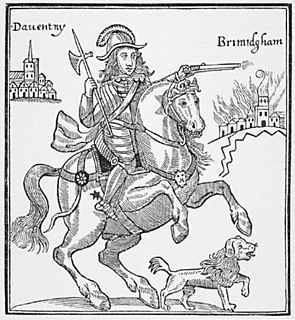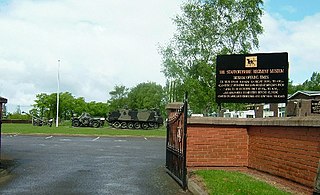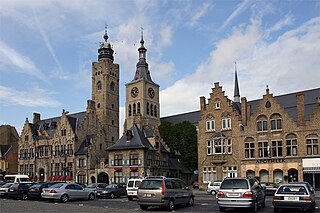Related Research Articles

An army, ground force or land force is a fighting force that fights primarily on land. In the broadest sense, it is the land-based military branch, service branch or armed service of a nation or country. It may also include aviation assets by possessing an army aviation component. Within a national military force, the word army may also mean a field army.

The Battle of Agincourt was an English victory in the Hundred Years' War. It took place on 25 October 1415 near Azincourt, in northern France. The unexpected English victory against the numerically superior French army boosted English morale and prestige, crippled France and started a new period of English dominance in the war.

The English Civil War (1642–1651) was a series of civil wars and political machinations between Parliamentarians ("Roundheads") and Royalists ("Cavaliers"), mainly over the manner of England's governance and issues of religious freedom. It was part of the wider Wars of the Three Kingdoms. The first (1642–1646) and second (1648–1649) wars pitted the supporters of King Charles I against the supporters of the Long Parliament, while the third (1649–1651) saw fighting between supporters of King Charles II and supporters of the Rump Parliament. The wars also involved the Scottish Covenanters and Irish Confederates. The war ended with Parliamentarian victory at the Battle of Worcester on 3 September 1651.

Mercia was one of the three notable Anglic kingdoms founded after as Sub-Roman Britain was settled by Anglo-Saxons in an era called the Heptarchy. It was centred around the River Trent and its tributaries, in a region now known as the Midlands of England.

Mutiny is a revolt among a group of people to oppose, change, or overthrow an organization to which they were previously loyal. The term is commonly used for a rebellion among members of the military against an internal force, but it can also sometimes mean any type of rebellion against any force. Mutiny does not necessarily need to refer to a military force and can describe a political, economic, or power structure in which there is a change of power.

The Battle of Worcester took place on 3 September 1651 at Worcester, England. It was the final battle of the English Civil War. Oliver Cromwell's Parliamentary New Model Army, 28,000 strong, defeated King Charles II's 16,000 Royalists, of whom the vast majority were Scottish.

Lichfield is a cathedral city and civil parish in Staffordshire, England. Lichfield is situated roughly 18 miles (29 km) south-east of the county town of Stafford, 8.1 miles (13.0 km) south-east of Rugeley, 9 miles (14 km) north-east of Walsall, 7.9 miles (12.7 km) north-west of Tamworth and 13 miles (21 km) south-west of Burton Upon Trent. At the time of the 2011 Census, the population was estimated at 32,219 and the wider Lichfield District at 100,700.
Lawrence v. Texas, 539 U.S. 558 (2003), was a landmark decision of the U.S. Supreme Court in which the Court ruled that sanctions of criminal punishment for those who commit sodomy are unconstitutional. The Court reaffirmed the concept of a "right to privacy" that earlier cases, such as Roe v. Wade, had found the U.S. Constitution provides, even though it is not explicitly enumerated. The Court based its ruling on the notions of personal autonomy to define one's own relationships and of American traditions of non-interference with private sexual decisions between consenting adults.

A man-at-arms was a soldier of the High Medieval to Renaissance periods who was typically well-versed in the use of arms and served as a fully armoured heavy cavalryman. A man-at-arms could be a knight, or other nobleman, a member of a knight's or nobleman's retinue, or a mercenary in a company serving under a captain. Such men could serve for pay or through a feudal obligation. The terms knight and man-at-arms are often used interchangeably, but while all knights equipped for war certainly were men-at-arms, not all men-at-arms were knights.
The city of Birmingham, in England, has a long military history and has been for several centuries a major manufacturer of weapons. It may have been between Warwickshire and Worcestershire.
The Battle of Holmedon Hill or Battle of Homildon Hill was a conflict between English and Scottish armies on 14 September 1402 in Northumberland, England. The battle was recounted in Shakespeare's Henry IV, part 1. Although Humbleton Hill is the modern name of the site, over the centuries it has been variously named Homildon, Hameldun, Holmedon, and Homilheugh.

The Battle of Baugé, fought between the English and a Franco-Scots army on 22 March 1421 at Baugé, France, east of Angers, was a major defeat for the English in the Hundred Years' War. The English army was led by the king's brother Thomas, Duke of Clarence, while the Franco-Scots were led by both John Stewart, Earl of Buchan, and Gilbert Motier de La Fayette, the Marshal of France. English strength was 4,000 men, although only 1,500 deployed, against 5,000 French and Scots.
The Assize of Arms of 1181 was a proclamation of King Henry II of England concerning the obligation of all freemen of England to possess and bear arms in the service of king and realm and to swear allegiance to the king, on pain of "vengeance, not merely on their lands or chattels, but on their limbs". The assize stipulated precisely the military equipment that each man should have according to his rank and wealth. The assize effectively revived the old Anglo‐Saxon fyrd duty. The Assize established restrictions on weapon ownership by Jews, terms of inheritance, and prohibition of exports of arms, ships and timber.
Every knight was forced to arm himself with a coat of mail, and shield and lance; every freeholder with lance and hauberk, every burgess and poorer freeman with lance and an iron helmet. This universal levy of the armed nation was wholly at the disposal of the king for defense. ... By his Assize of Arms Henry restored the Ancient Anglo-Saxon Militia System, and supplied the requisite counterbalance to the military power of the great feudatories, which, notwithstanding the temptation to avoid service by payment of scutage, they were still able and too willing to maintain.
In all these measures we may trace one main object, the strengthening of the Royal power, and one main means, or directing principle—the doing so by increasing the safety and security of the people. Whatever was done to help the people, served to reduce the power of the great feudal baronage, to disarm their forces, to abolish their jurisdictions, to diminish their chances of tyranny.
The Bower is a festival held each spring on a bank holiday in Lichfield, England. A statute of Henry II of England ordered that all men capable of bearing arms should be inspected by the magistrates. Since there was no standing army, this was a way to find out how many men could fight in a war. The men would then march through the streets and retire at a "Bower House" for roast beef and spirits, ensuring a good turn-out.
The Battle of Boroughmuir was fought on 30 July 1335 between Guy, Count of Namur, a cousin of Queen Philippa of England, and John Randolph, 3rd Earl of Moray and Guardian of Scotland. Namur was on his way to join Edward III on his invasion of Scotland, when he was intercepted on the common grazing ground to the south of Edinburgh - the Borough Muir. The fighting continued into the city itself, and concluded in a desperate struggle in the ruins of the old castle. Randolph was victorious in a fight which forms a small part of the Second War of Scottish Independence.

The Lancastrian War was the third and final phase of the Anglo-French Hundred Years' War. It lasted from 1415, when King Henry V of England invaded Normandy, to 1453, when the English lost Bordeaux. It followed a long period of peace from the end of the Caroline War in 1389. The phase is named after the House of Lancaster, the ruling house of the Kingdom of England, to which Henry V belonged.

The Battle of Camp Hill took place on Easter Monday, 3 April 1643, in and around Camp Hill, Warwickshire, during the First English Civil War. In the skirmish, a company of Parliamentarians from the Lichfield garrison with the support of some of the local townsmen, approximately 300 men, attempted to stop a detachment of 1,400 Royalists under the command of Prince Rupert from passing through the unfortified parliamentary town of Birmingham.

DMS Whittington, otherwise known as Defence Medical Services Whittington, is a military base in Whittington, Staffordshire, near Lichfield in England. It is home to the Staffordshire Regiment Museum, the Headquarters of the Surgeon General and subordinate medical headquarters, and the location of the Defence College of Health Education and Training.

Minutemen were members of the organized New England colonial militia companies trained in weaponry, tactics, and military strategies, comprising the American colonial partisan militia during the American Revolutionary War. They were known for being ready at a minute's notice, hence the name. Minutemen provided a highly mobile, rapidly deployed force that enabled the colonies to respond immediately to war threats. They were an evolution from the prior colonial rapid-response units.

The Capitulation of Diksmuide, or Dixmuide, then in the Spanish Netherlands, took place from 26 to 28 July 1695, during the 1689 to 1697 Nine Years' War. An Allied garrison of around 4,000 men surrendered to a superior French force.
References
- Lichfield City Council Customs and Traditions
- Green Man's Morris and Sword Club Birmingham The Lichfield Bower